What walks without feet, captures prey without eyes, and looks stunning in a reef tank? Sea anemones!
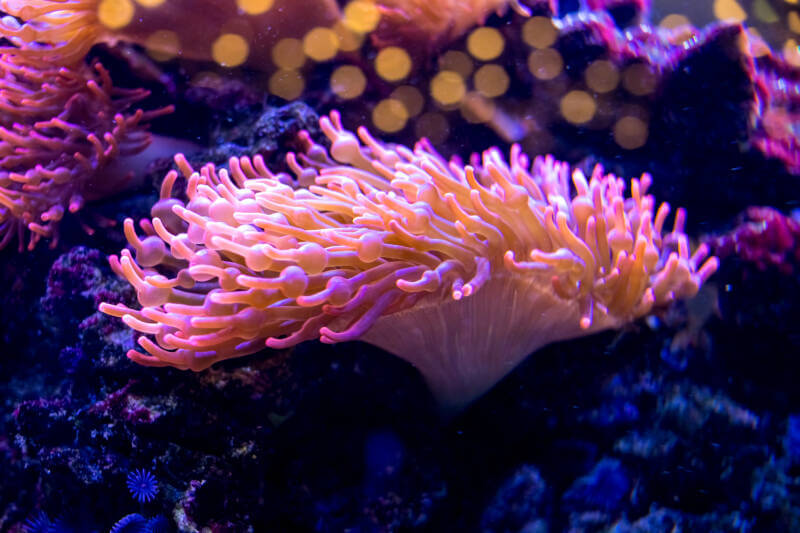
These oceanic flowers enchant aquarists with their floating tentacles, available in a variety of gorgeous colors. And their unique biology enhances the appeal.
Sea anemones fall under the order Actiniaria. They then get divided into FORTY-SIX families.
And if that’s not enough to blow your mind, there are over ONE THOUSAND different species of these creatures that straddle the line between coral and jellyfish.
Anemones combine the best of both worlds. They consist of a polyp that attaches to a basal disc. The body then extends outward, surrounding an oral disc for taking in food. And rising from the body? Tentacles containing nematocysts – the same stinging cells found in jellyfish.
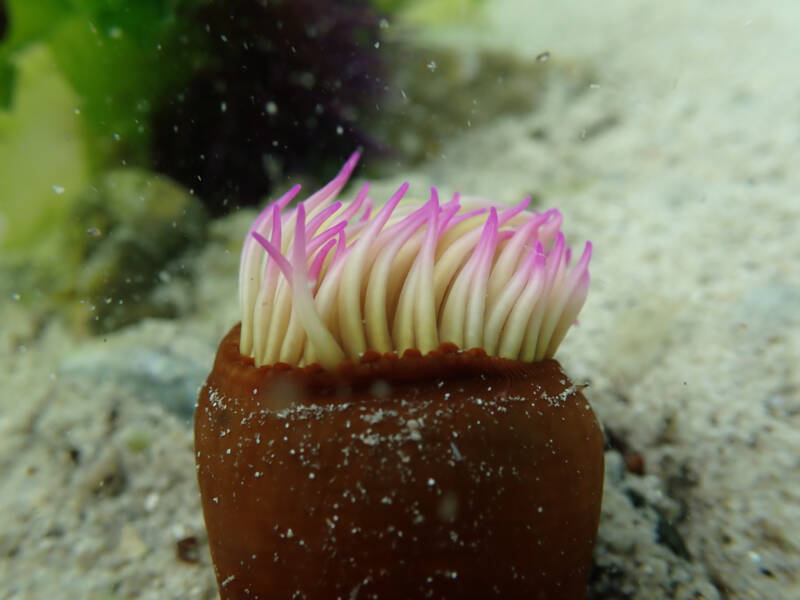
Intrigued? Well, before you rush out to add an anemone to your saltwater aquarium, make sure you have all of the facts.
These unique little animals aren’t for everyone. And depending on the anemone species you choose, you may end up biting off more than you can chew.
[toc]
The Sea Anemone Tank

It’s tempting to drop an anemone into a reef tank and sit back. However, doing so will likely result in the death of your poor tentacled beauty.
Despite those stinging cells for defense and sustenance, sea anemones are quite delicate.
You should only consider anemones if you have a mature, fully-cycled saltwater aquarium.
They’re extremely sensitive, especially to change. If you’re struggling to get the balance correct, you could find yourself with a shriveled anemone – a sign of problems.
Anemones tend to enjoy the same water conditions as SPS (small polyp stony) and LPS (large polyp stony) corals. And the more stable your system, the happier and better off your sea anemones will be.
| Parameter | Value |
| Salinity | 1.024-1.026 |
| Temperature | 76-78°F (24.4-25.5°C) |
| pH | 8.1-8.3 |
| Alkalinity | 8.0-12 dKH |
| Calcium | 400-450 ppm |
| Magnesium | 1250-1350 ppm |
| Nitrates | < 2 ppm (0 ppm is best) |
| Phosphates | 0.002 ppm (0 ppm is best) |
| Ammonia | 0 ppm |
| Nitrites | 0 ppm |
Anemone Lighting: Keeping the Zooxanthellae Happy
Taking cues from their coral side, sea anemones share a symbiotic relationship with zooxanthellae.
These algae live within the flesh of their bodies, providing a supplementary part of their diet. This means lighting in your reef tank is critical (same as you find for corals).
You want to look for medium to high-intensity lighting options to keep those zooxanthellae working at optimum levels.
Without the proper conditions, your anemone will wither like a flower lacking nutrients. (Which is precisely what’s happening)
If you don’t feel confident managing a light-restrictive species, you’re in luck. There are anemone species that aren’t as fussy in their light demands.
And you won’t have to sacrifice any beauty in your marine tank, either. It just requires some homework on your part.
Safety First
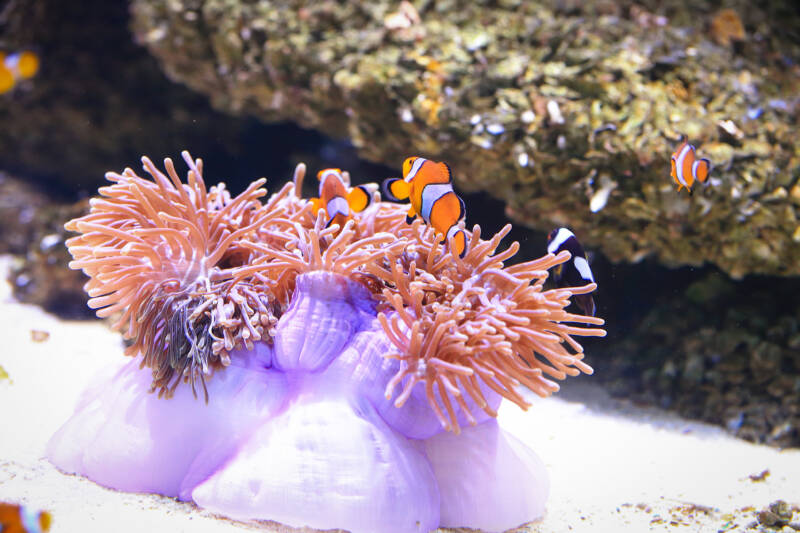
Corals establish themselves within a tank. While they continue to lay down calcium skeletons throughout their lives, the original placement doesn’t tend to change.
Anemones break that tradition. They have nomadic roots from their jellyfish side.The basal disc contains an adhesive foot that anchors the sea anemone to its substrate of choice.
But if conditions aren’t to their liking, they can lift that foot and wander the tank. Some anemone species “walk” around more than others.
The movement is a clue you need to check your water conditions. Anemones often change position due to unsatisfactory water conditions. They’re checking for a better place to settle down, with water more to their liking.
However, sea anemones don’t have eyes. So they’re wandering blind. And if you haven’t “anemone-proofed” your reef tank, they’ll get injured.
Install screens over any pumps or powerheads to prevent the tentacles from getting sucked into the equipment.
Food and Diet
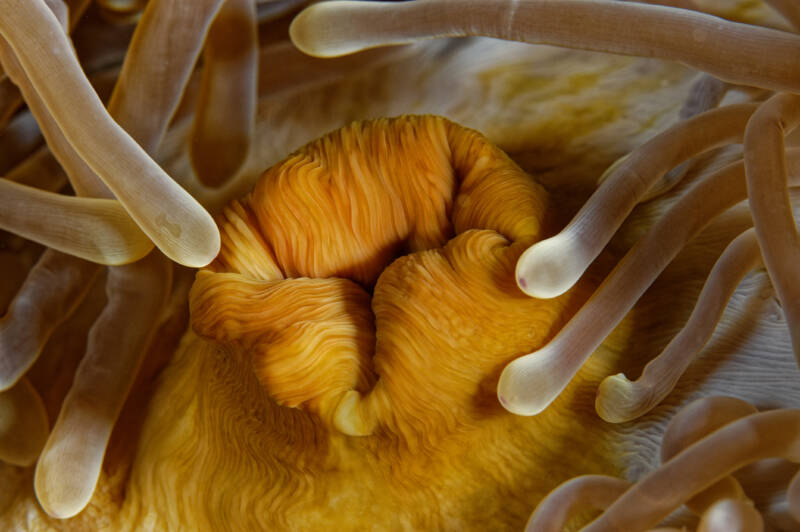
With awareness of those zooxanthellae, it’s tempting to think you don’t need to worry about diet for your sea anemone.
But the algae are only the supplements on the menu. Anemones are carnivores, and they appreciate fresh sources of protein.
At least twice a week, depending on the species (and size) of your anemone, you need to chop up a meaty course for your sea anemone.
Want to know if they’re hungry? Look for slightly-opened mouths. That’s a sign they’d like a meal.
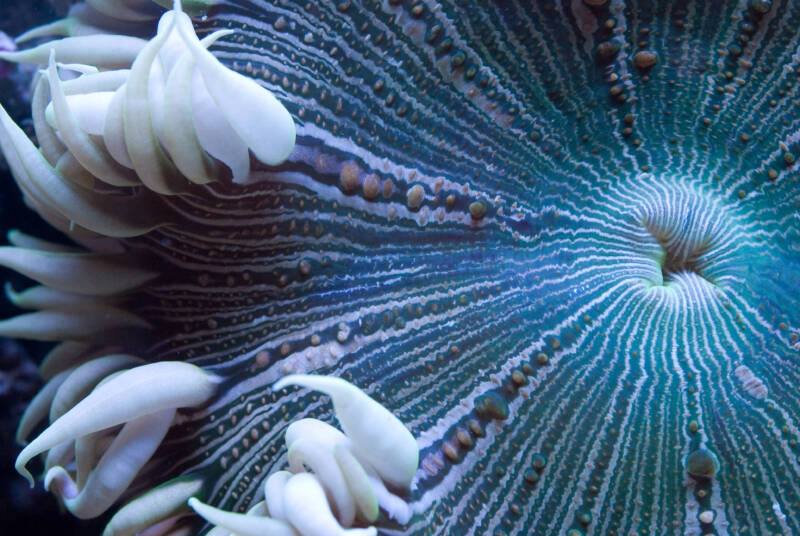
Monitor your amounts carefully so you don’t add extra nitrogenous waste to the tank. Remember, anemones are sensitive to poor water quality. If you see them eject a pellet of partially-digested food, cut back. Anemone favorites include:
- Clams
- Krill
- Mussels
- Scallops
- Shrimp.
Reproduction: All the Methods
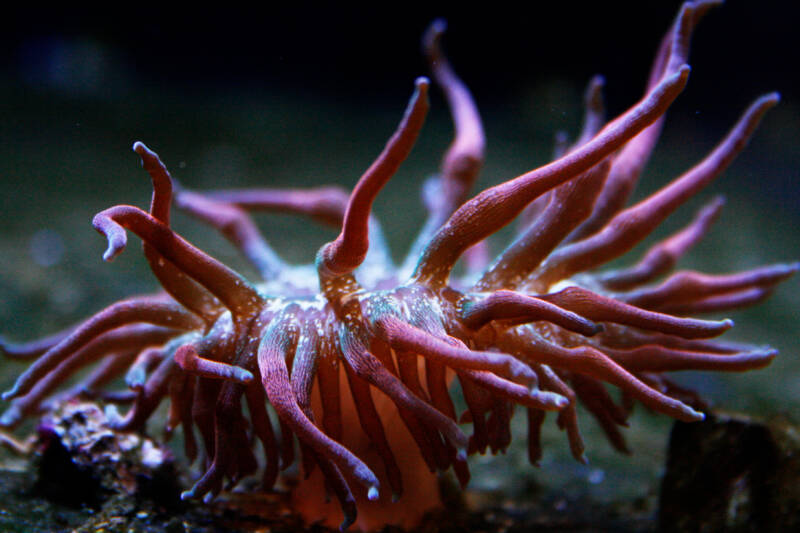
Sea anemones utilize every method of reproduction. It depends on the species as to which you may see.
Make sure you’ve researched your anemone species to know what to expect (or not expect, in case you only have one anemone).
Some species release male and female gametes through the mouth. The eggs develop into planula larvae. The planula find suitable resting places, then develop into polyps that grow into recognizable anemones.
You can also see asexual method – some anemone bud. Tiny anemones peel off to set up a new colony. Or you can see binary fission, where the entire sea anemone divides into two halves. Then each half wanders off on its own.
Types of Sea Anemones
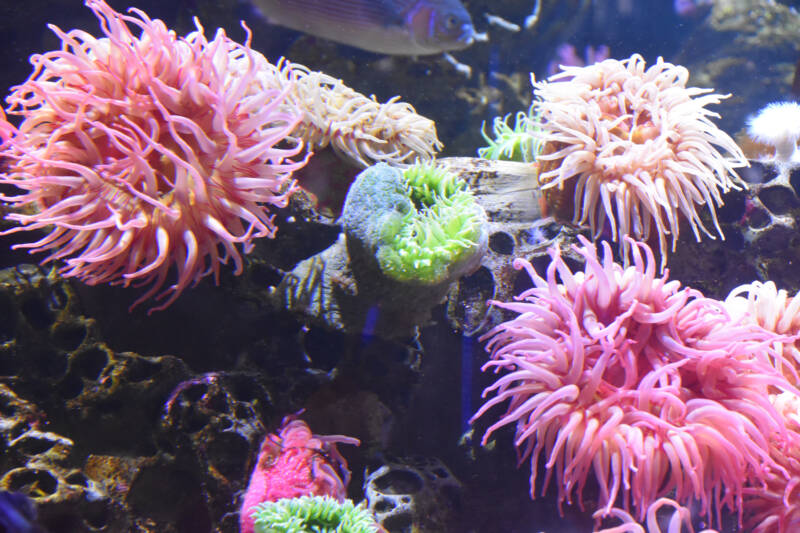
When you contemplate the possibility of a thousand species, it sounds like you’re spoiled for choice.
However, many species aren’t suited for captivity. They can grow to ridiculous sizes, harbor aggressive habits, or end up too delicate for transport.
Luckily, you still have plenty of anemone species to choose from that DO handle reef tanks without much trouble. You want to consider your choices carefully, though. And you need to consider your capabilities realistically.
Sea anemones possess nematocysts. Not every sting will hinder you, but it WILL cause pain. (Jellyfish stings have that range, too)

Always wear gloves when you handle your anemone. The precaution protects you from a potential reaction to the toxin, even if it isn’t horrible.
Some fish suppliers dye anemone species in various colors. It’s a crazy practice. After all, sea anemones come in vibrant shades already.
The dying leads to an early death for the anemone. Make sure you avoid any color that looks unnatural.
It’s tempting to combine sea anemones and coral. The two look stunning and ARE found together in reefs throughout the world. You need to consider your spacing carefully.
The two (and even different anemones) WILL wage chemical warfare with one another!
1. Beadlet Anemone (Actinia equina)
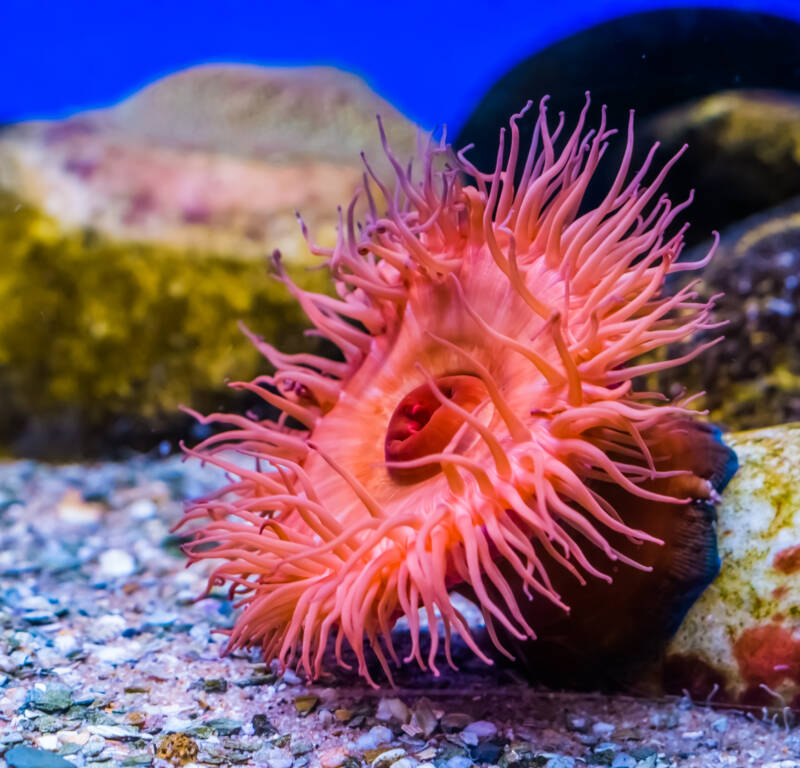
- In the Wild: Eastern Atlantic, Mediterranean
- Length: 1-2.75 inches (2.5-7 cm)
- Difficulty: Moderate-Difficult
- Tank Size: 20 gallons (75 l)
- Lifespan: 80 years
- Cost: $20
You’d be hard-pressed to find a sturdier anemone than the beadlet anemone.
This hardy creature endures changes in temperature, salinity, and even water level! As long as it doesn’t completely dry out, it handles coming out of the water. (Please don’t try this at home)
When the beadlet’s exposed to air, the tentacles retract, and the body closes up to protect the delicate animal. People overlook them as colorful blobs out on the rocks.

It’s a survival mechanism and not one you encounter in too many other anemone species.
They’re on the small side, allowing aquarists to keep them in nano tanks. However, they’re not tropical. This means managing a chiller to get their water temperature needs correct. Cold water is trickier than warm, so they’re not for novice aquarists.
Some people confuse them with the Australian red waratah anemone.

Both come in red colors, but the similarity ends there. Waratahs need TROPICAL conditions. Double-check any labels before you bring a beadlet home.
2. Tube Anemone (Cerianthus spp.)
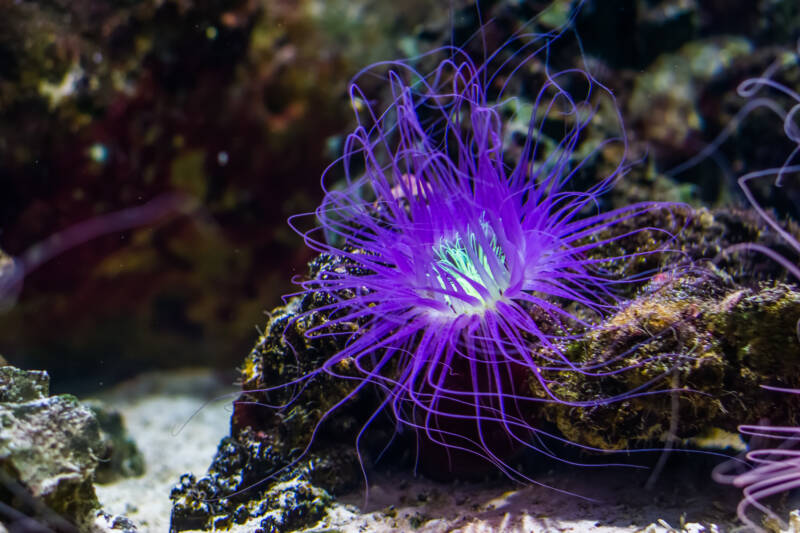
- In the Wild: Northeastern Atlantic, Mediterranean, Indo-Pacific
- Length: 8-12 inches (20-30 cm)
- Difficulty: Moderate
- Tank Size: 50 gallons (189 l)
- Lifespan: 5 years
- Cost: $80
Tube anemones get their name from the long tube they construct from specialized cells. Their long tentacles then extend out from the tube. Unlike some sea anemones, they can’t retract their tentacles back into the tube structure.
They’re one of the easier groups of anemones to manage. You won’t have to fuss with lighting conditions. They prefer things on the dimmer side. As long as they have a sandy substrate and a moderate water flow, they’re happy.
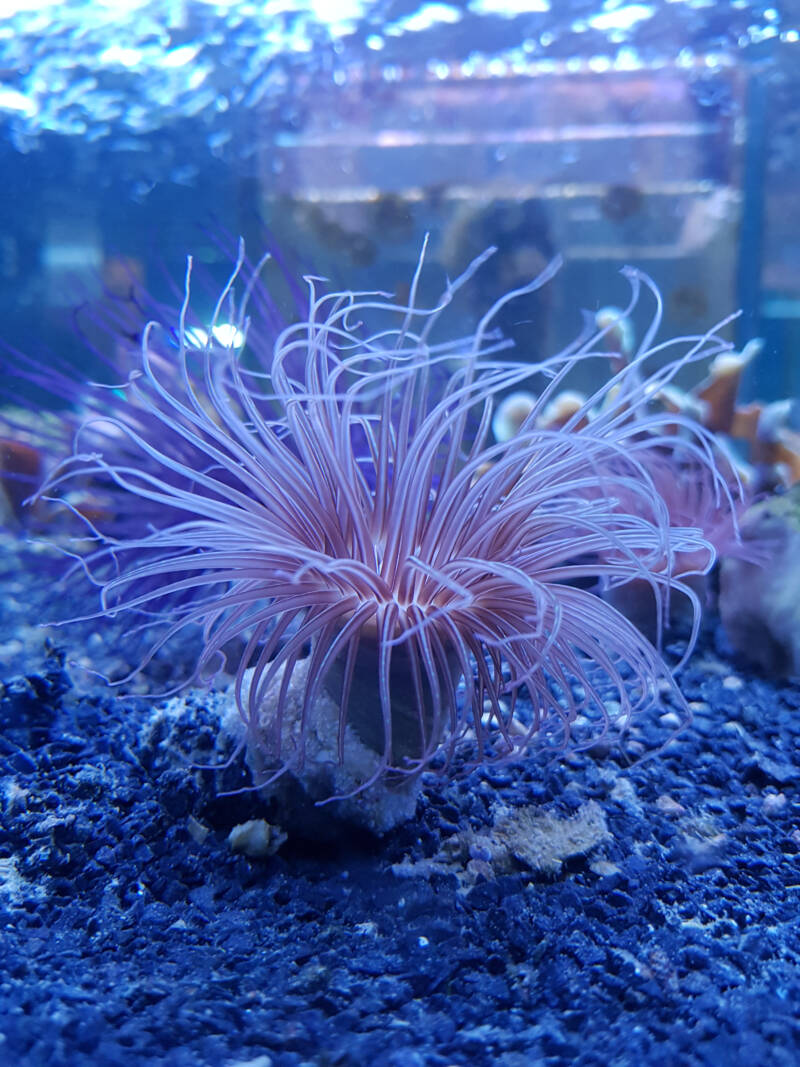
You WILL need to take care with your tank mates, though. Tube anemones are active predators.They’ll even take out clownfish without a second thought.
In general, they’re not colorful, but their unique appearance appeals to most aquarists.
3. Bubble Tip Anemone/Rose Bubble Anemone (Entacmaea quadricolor)
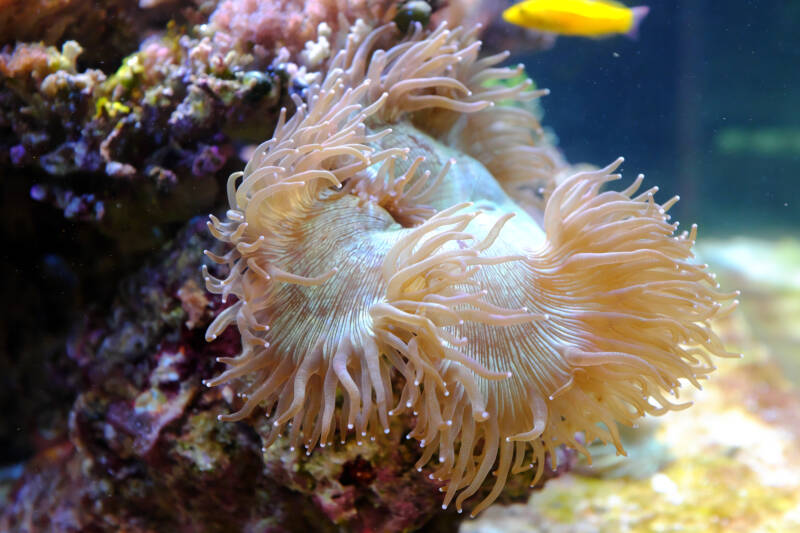
- In the Wild: Indo-Pacific
- Length: 12 inches (30 cm)
- Difficulty: Easy
- Tank Size: 30 gallons (113 l) MINIMUM
- Lifespan: 8 years
- Cost: $30-$40
If you’re starting your journey into anemones, the bubble tip anemone is the choice for you. They rank as the best anemone for novice aquarists.
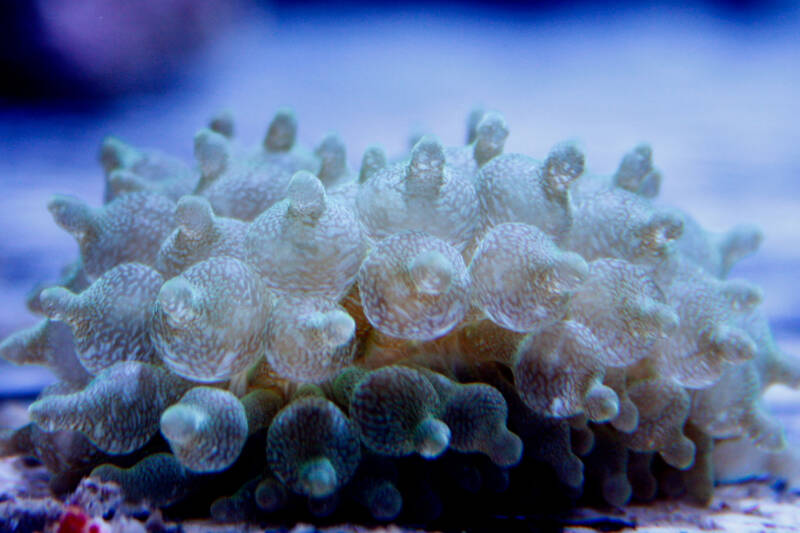
They’re beautiful, inexpensive, and delightful homes for clownfish, cleaner shrimp, and porcelain crabs.
Bubble tips get their name from the bulb at the ends of their tentacles. Some varieties have larger bulbs than others, and they tend to “deflate” them in lower lighting. Scientists believe the correlation is with their zooxanthellae.
One of the larger sea anemones, you want to maximize your aquarium to prevent crowding – especially if you have corals or other anemones.
Bubble tips aren’t as aggressive as other species, but they’re one of the biggest wanderers. Even in optimum water conditions!
They enjoy high light levels, but it’s not a requirement. They’ll adapt to whatever you offer.
It helps that they have long tentacles (up to 2 inches or 5 cm) when stretched out. And keep an eye on them – they undergo binary fission for reproduction!
4. Condy Anemone/Pink-Tipped Anemone (Condylactis gigantea)
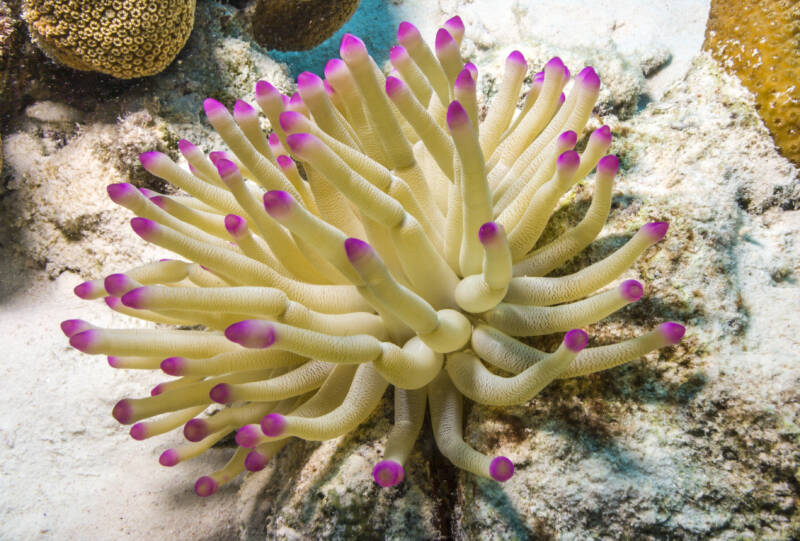
- In the Wild: Caribbean
- Length: Up to 20 inches (51 cm)
- Difficulty: Moderate
- Tank Size: 30 gallons (113 l)
- Lifespan: 8 years
- Cost: $5-$10
Condy anemones combine a hardy nature with natural beauty. They inhabit rocky substrates in shallower waters of the Caribbean.
As such, you won’t see them pairing up with clownfish (they’re not native to the area). However, cleaner shrimp and crabs like them.
The name comes from the pink tips at the very ends of their tentacles. When stressed, though, they collapse in on themselves. A shriveled anemone is NEVER a good sign. It means you need to do a quick water chemistry check.
Condy anemones have a potent sting designed for taking out fish that come too close.
They’re also one of the larger sea anemone species kept in captivity. Wear your gloves and keep an eye out. They like to roam the tank at random.
5. Haddon’s Carpet Anemone/Saddle Carpet Anemone (Stichodactyla haddoni)
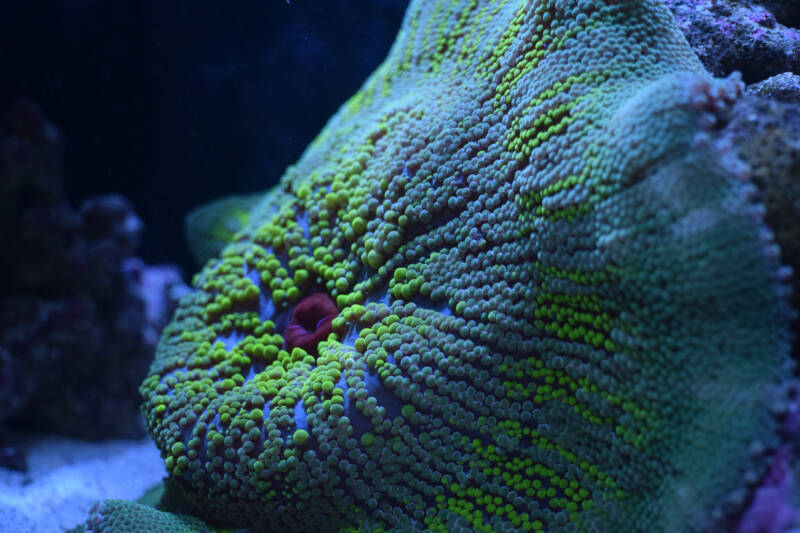
- In the Wild: Indo-Pacific
- Length: 2 feet (61 cm)
- Difficulty: Moderate-Difficult
- Tank Size: 75 gallons (284 l)
- Lifespan: 8 years
- Cost: $50
Haddon’s carpet anemones come in various colors: everything from sandy shades of brown to greens, blues, and purples.
You won’t see long, sweeping tentacles, though; they’re short and sticky. And inside? A sting you WILL feel, especially along thinner skin.
Aquarists often pick up juvenile Haddon’s anemones when they’re around 4 inches (10 cm).
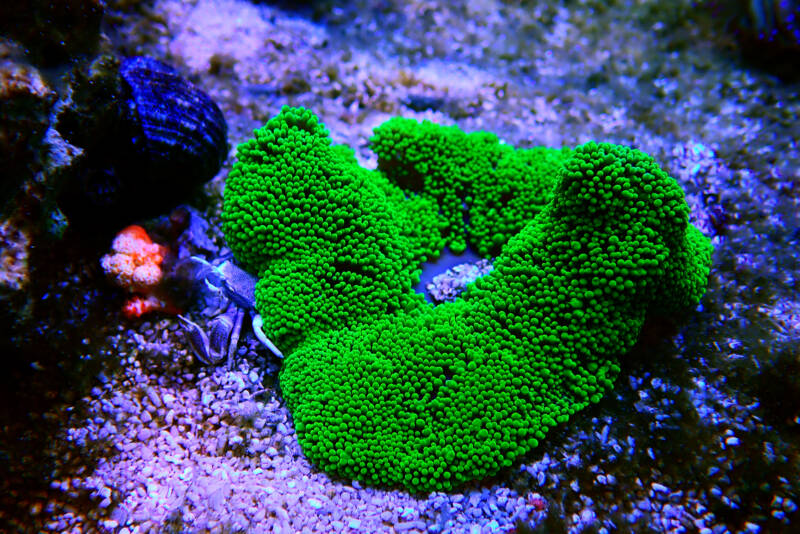
Which is fine until these fast-growers swamp an undersized marine tank. They quickly top 2 feet (61 cm) in no time. You need a MASSIVE aquarium to support them properly.
They’re not as prone to walk through the tank (good thing!). However, they prefer sandy substrates.
You’ll want around 3-6 inches (7-15 cm) of sand so they can anchor their foot comfortably. When threatened, they submerge entirely in the substrate.
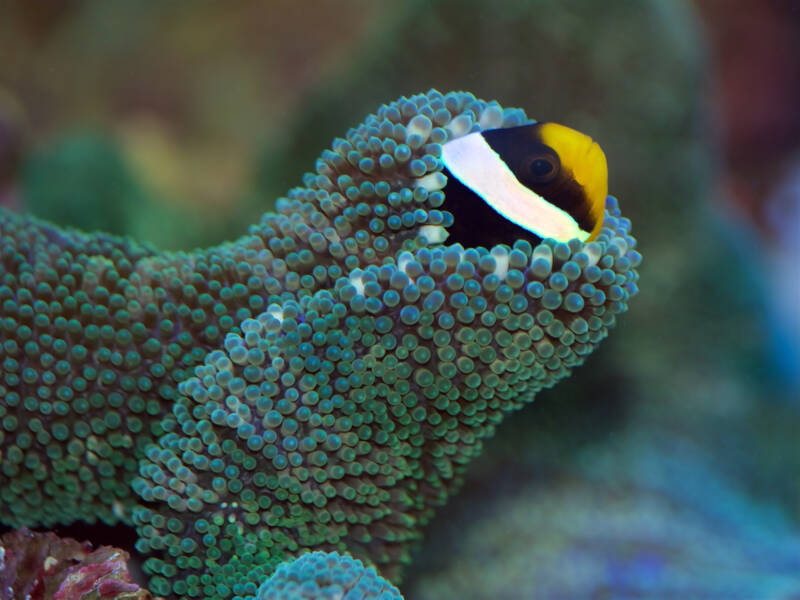
The difficulty of the Haddon’s anemone comes from their lighting and water flow needs.
You can’t get away with subdued lighting. The stubby tentacles mean they need high-intensity light. And they want a moderate water current throughout the aquarium.
6. Knobbly Anemone (Bunodosoma capensis)
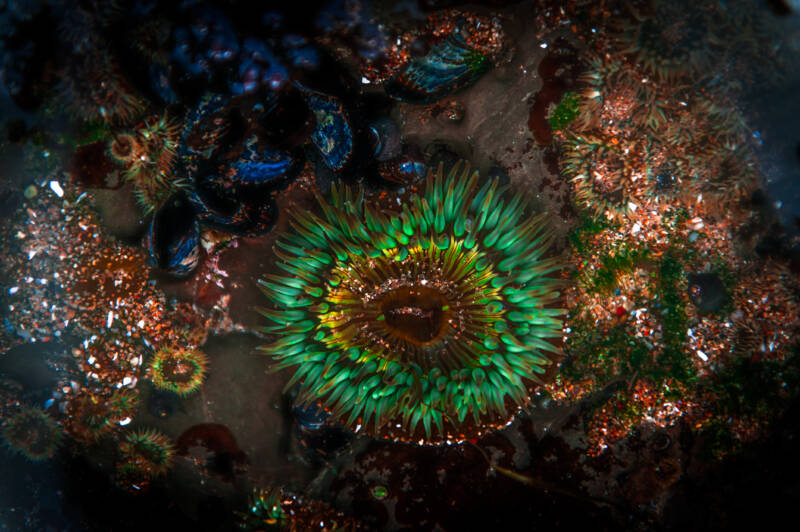
- In the Wild: Southern Africa
- Length: 4-80 inches (10 cm-2 m)
- Difficulty: Uncertain
- Tank Size: Unknown
- Lifespan: Unknown
- Cost: Unknown
Divers love the striking appearance of the knobbly anemone. Vibrant colors shade the body and the series of “knobs” that line the anemone.
Unlike other anemone species, no part of the knobbly anemone is sticky, so sand and shell debris don’t adhere to it.
Knobbly anemones prefer rocky terrain. They stick to rock pools and reefs along the shores from Namibia to KwaZulu-Natal.
They’re stunning to look at, but they’re not yet popular in aquariums. You’ll have to admire them from afar.
7. Long Tentacle Anemone/Corkscrew Anemone (Macrodactyla doreensis)
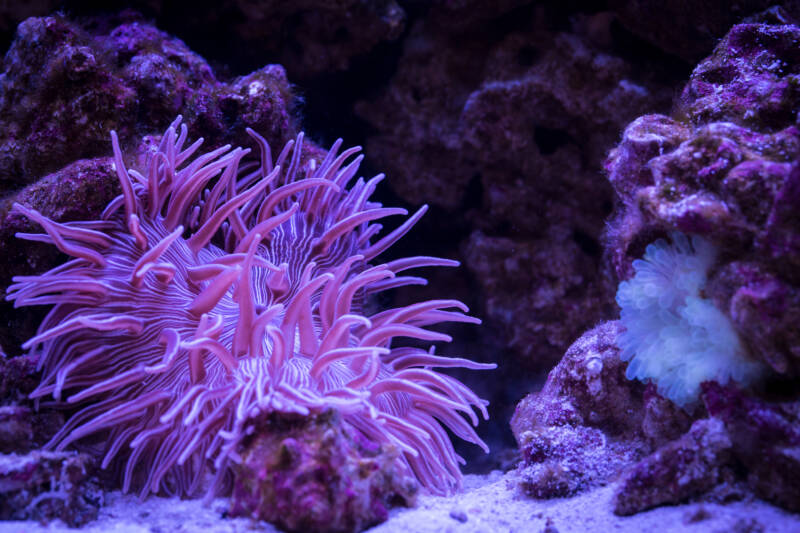
- In the Wild: Indo-Pacific
- Length: 20 inches (51 cm)
- Difficulty: Moderate
- Tank Size: 30 gallons (113 l)
- Lifespan: 8 years
- Cost: $60-$100
As you might expect from the name, long tentacle anemones have exceptionally long tentacles.
A flattened oral disc serves as the base for the circle of sweeping, smooth tentacles extending out in a dramatic display.
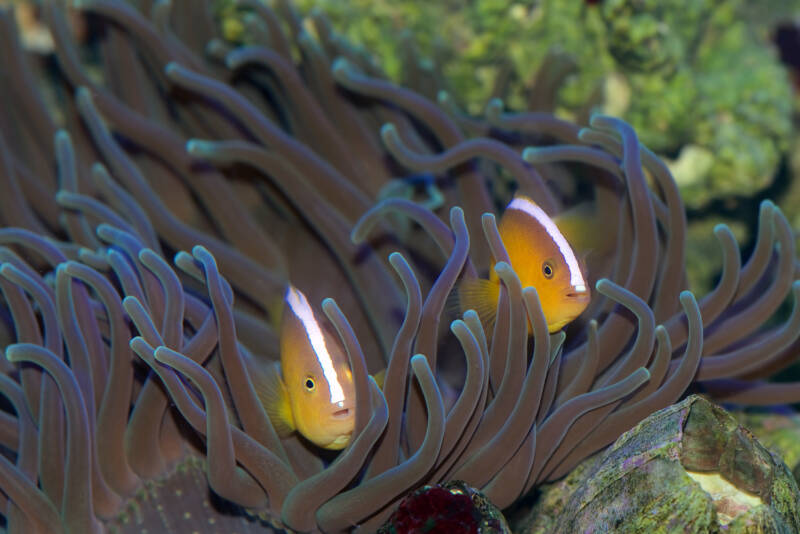
You’ll see plenty of color options for these sea anemones. And they come in different names: corkscrew anemone, sand anemone, and red base anemone.
As you can probably guess, they prefer substrates of mud or sand as their anchoring source.
Corkscrews are pretty hardy. They do want moderate lighting for those long tentacles, though. And they expect a moderate water flow.As such, you’re better holding off on this species until you feel confident with your aquarist skills.
8. Ritteri Anemone (Heteractis magnifica)
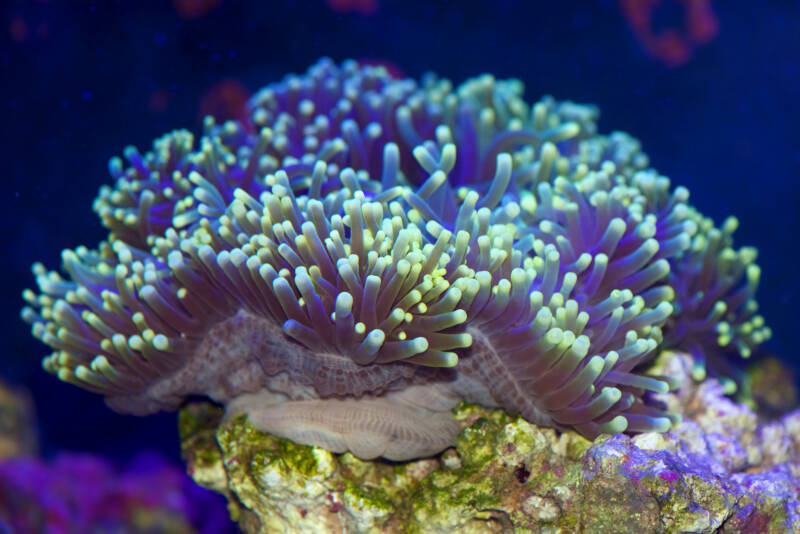
- In the Wild: Indo-Pacific
- Length: 35 inches (89 cm) in the wild; 16-18 inches (40-46 cm) in captivity
- Difficulty: Difficult
- Tank Size: 50 gallons (189 l)
- Lifespan: 8 years
- Cost: $120-$180
While beautiful to behold, the ritteri anemone isn’t suited for most marine tanks. When properly taken care of, these sea anemones can reach sizes up to 3.3 feet (1 m!).
Maintaining an aquarium of a proper size is beyond the scope of most people.
Ritteri are always demanding in their care needs. You need pristine water conditions (of course) and INTENSE lighting. They’re superb symbionts with their zooxanthellae, and they won’t tolerate anything less. You also need A LOT of water movement throughout the tank.
And as if the enormous tank size (and demands) weren’t enough, ritteri anemones like to go for walks. They’re very mobile, even with good water quality.
Unfortunately, they’re also one of the anemone species often targeted for dying. (Which is why they don’t last long)
9. Rock Flower Anemone (Phymanthus crucifer)
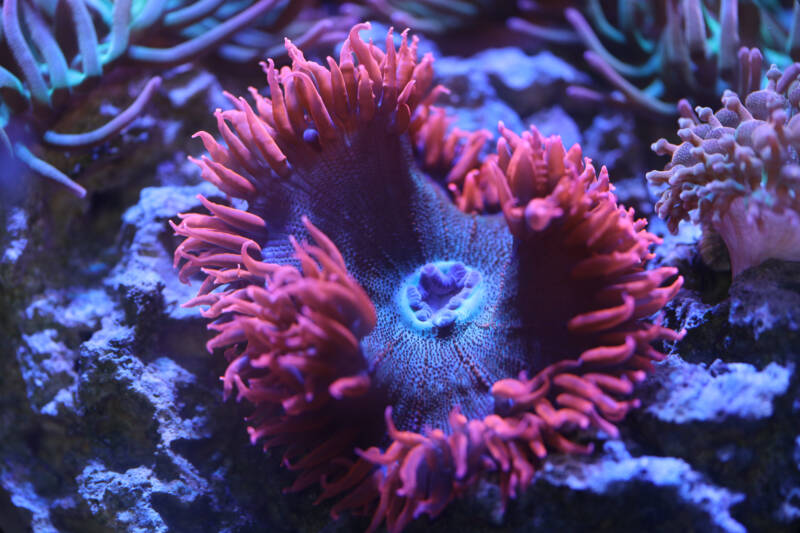
- In the Wild: Caribbean
- Length: 6-8 inches (15-20 cm)
- Difficulty: Easy
- Tank Size: 20 gallons (75 l)
- Lifespan: 80 years
- Cost: $30-$40
Rock flower anemones enjoy a position as an easy sea anemone species. Aquarists of all levels keep them in their reef tanks.
They’re pretty common, especially given their intense colors. A few even fluoresce under ultraviolet light!

You won’t see your rock flowers cozying up to clownfish, but that’s because the two don’t share the same space in the ocean.
Rock flowers DO form symbiotic relationships with cardinalfish, though, and they don’t mind the occasional porcelain crab.
When you set up your tank for a rock flower anemone, consider adding high-intensity lights. They won’t perish without it, but they’ll appreciate it. They also enjoy a moderate water flow.
And, luckily for you, once they settle into the sand, they don’t tend to walk.
10. Sebae Anemone (Heteractis crispa)
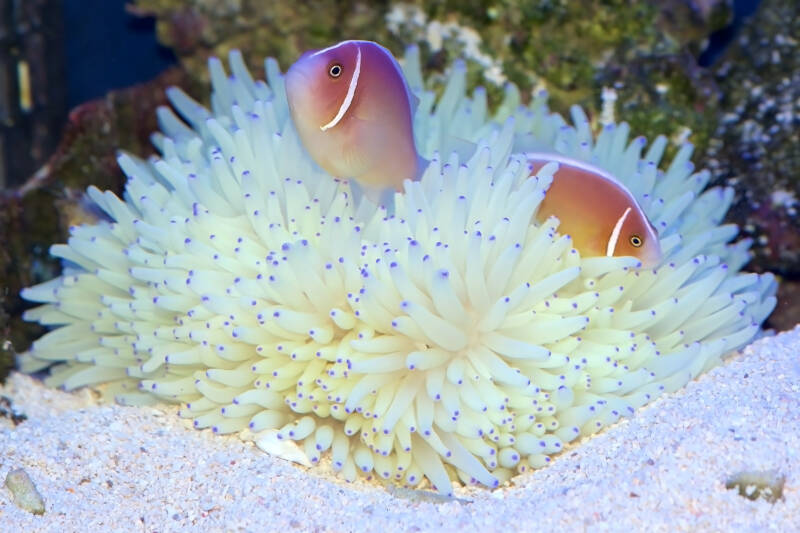
- In the Wild: Indo-Pacific
- Length: 20-50 inches (75-89 cm)
- Difficulty: Difficult
- Tank Size: 50 gallons (189 l)
- Lifespan: 80 years
- Cost: $40-$80
Sebae anemone reach similar sizes to ritteri, and they have the same kind of care needs. You’ll want to make sure you’re prepared for the investment before you decide to bring your sea anemone polyp home.
Clownfish adore sebae anemone. They form a symbiotic relationship with the anemone as it attaches to rocky substrates.
It’s one of the reasons aquarists love the species so much. After all, who doesn’t want Nemo swimming around their tank?
Unfortunately, sebae often fall prey to poor selling techniques. Never buy a “white” anemone.
Healthy anemones aren’t pure white. That means their zooxanthellae bailed due to improper handling, poor water quality, or other neglectful habits. Your anemone will die shortly.
11. Starburst Anemone (Anthopleura sola)
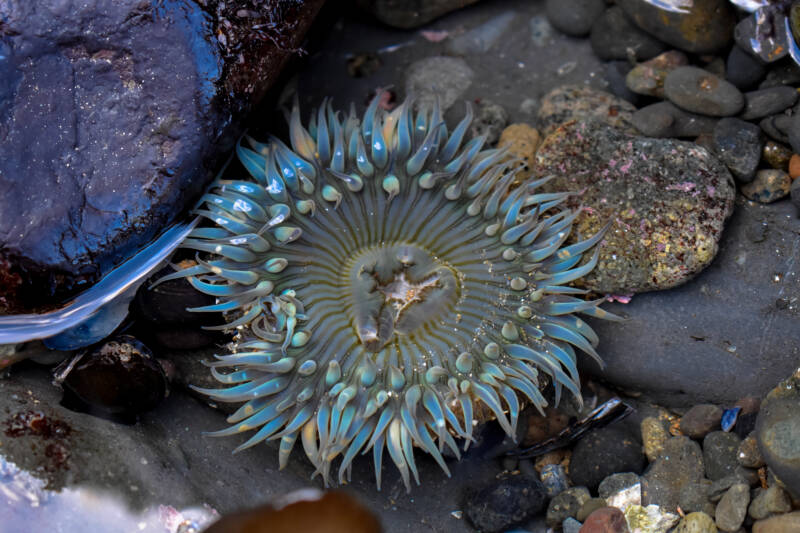
- In the Wild: Northwest Pacific
- Length: 5-10 inches (12-25 cm)
- Difficulty: Moderate
- Tank Size: 30 gallons (113 l)
- Lifespan: 60-80 years
- Cost: Unknown
The starburst or sunburst anemone is considered a solitary anemone. Rather than forming colonies or aggregates, they live alone.
And they aggressively go after any colony that comes near them. The sting from their nematocysts causes necrosis, forcing the intruder to move.
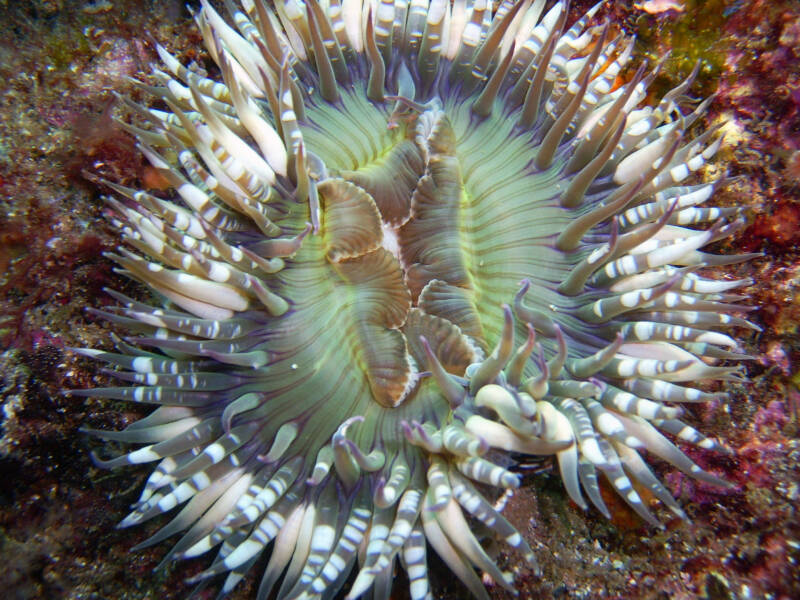
Starbursts hang out in the intertidal zone of rocky habitats. They squeeze into cracks and crevices. When the tide goes out, they close up, with shells or sand adhering to their body as a kind of protective armor.
You’ll see starburst anemones in varying shades of green. They extend their tentacles when submerged.
And they’re often seen by divers in the kelp forests off the coasts of California and Baja California.
Stinging Beauty
Sea anemones leave you staring in wonder for hours. They wave their tentacles through the water, hoping to entice something close.
True, it’s for a snack, but the movements are hypnotizing. And the more colorful, the more dazzling the display.
You need to consider your anemone placement carefully. They can’t see, and they may blunder into a pump or powerhead unexpectedly.
Or they may start a battle with the corals you already set up in the tank. It’s a thought process you want to give plenty of time.
But the variety and unique biology of a sea anemone are hard to resist.
And they’re the perfect addition to many reef tanks. If you can care for their zooxanthellae (and mind their stinging cells), you’re set.
Do you have anemones in your tank? Which species?
Have you ever received a sting?
Share your stories and questions with us here.
